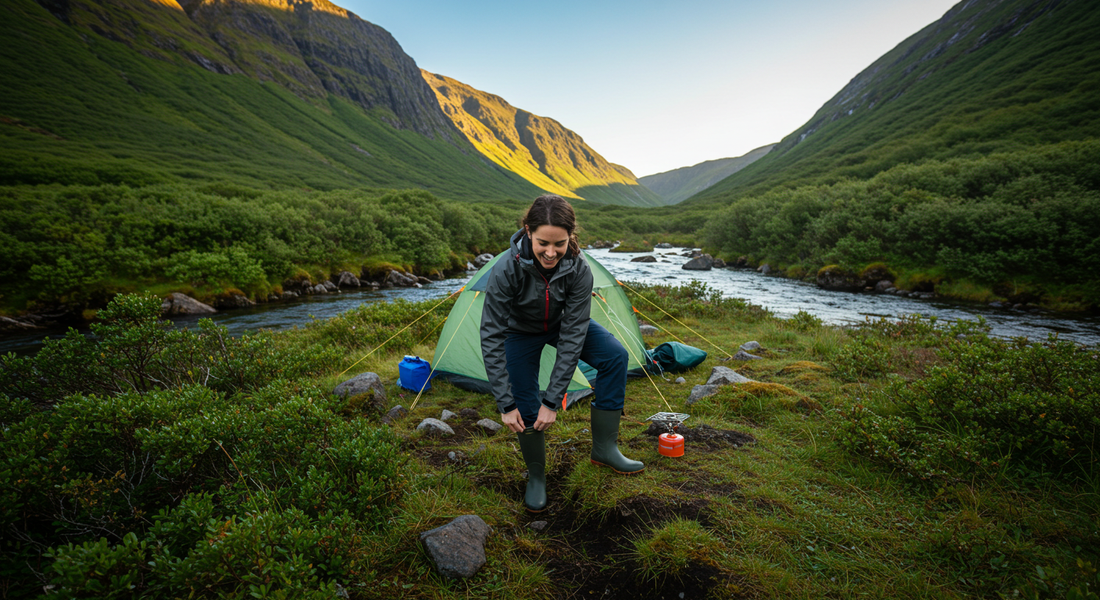
Essential Items and Tips for Camping in the Rain
Share
1. Choose a Truly Waterproof Tent & Rain Fly
When rain is expected, your shelter is the most important line of defense. Look for a tent with a high waterproof rating—often expressed in millimeters (mm) of hydrostatic head. A rain fly with full coverage that extends well past the tent door will help keep splatter from reaching the inner layer. Mesh panels promote ventilation but should have closure options to block wind-driven rain.
2. Invest in Quality Rain Gear
-
Rain Jacket and Rain Pants: A reliable jacket with waterproof, breathable fabric and sealed seams will save you many times. Pair with rain pants to keep your lower body dry.
-
Layering System: Wear moisture-wicking base layers, insulating mid-layers, and then waterproof outer layers. This layering lets you manage changing temperatures and activity levels.
-
Waterproof Boots or Shoes: Waterproof hiking boots or shoes with good grip help avoid slipping on wet terrain and protect your feet from getting soaked. Gaiters can also help if you’re walking through puddles or streams.
3. Ground Protection and Tent Site Selection
-
Ground Tarp or Footprint: Place a tarp under your tent to prevent water from seeping in from below. Be sure it doesn’t extend beyond the edges of the tent to avoid collecting pooling rain.
-
Elevated Sleeping Pad: A high-quality sleeping pad with insulation not only adds comfort but lifts you off cold, damp ground.
-
Choose Your Site Wisely: Avoid valleys or depressions where water collects. Look for natural drainage paths upslope and select flat but slightly sloped sites so rainwater runs away.
4. Keep Your Gear Dry & Organized
-
Dry Bags & Waterproof Stuff Sacks: Store clothes, electronics, and sleeping gear inside waterproof sacks. Even towels and extra socks should be sealed if you want to stay warm.
-
Pack Rain Covers for Backpacks: If your pack isn’t waterproof, a rain cover will protect everything inside.
-
Set Up a Dry Zone: Use pack covers, tarps, or canopy shelters to create a semi-sheltered area to change clothes, cook, or rest without getting wet.
5. Cooking Tips When It’s Wet
-
Windbreaks for Stove or Fire: Even under rain, a windbreak made of rocks or a portable shield helps maintain flame consistency.
-
Use Canopy or Tarp Shelter Above Cooking Area: A cooking area under a tarp keeps equipment dry and prevents flame flare-ups from rain.
-
Keep Matches/Lighter in Waterproof Container: Store fire-starting tools sealed so they ignite reliably when needed.
-
Opt for One-Pot Meals: Minimal cleanup in wet conditions is a relief; fewer dishes to wash or dry.
6. Dealing with Moisture Inside the Tent
-
Ventilation: Even in rain, some vents should remain open unless wind or heavy rain makes them unusable. Ventilation minimizes condensation building up inside.
-
Wet Gear Outside the Main Sleeping Area: Use vestibules or external pockets for wet boots or rain gear rather than storing them next to sleeping bags.
-
Quick-Dry Items: Use quick-dry towels, socks, and shirts. These reduce the time gear stays damp, which helps with comfort and reduces mildew.
7. Plan for Worst Case: Always Be Prepared
-
Check Weather Forecasts in Advance: Know when heavy rain or storms are coming. Adjust your itinerary or campsite if needed.
-
Bring Extra Dry Clothes: Even with all the precautions, you’ll appreciate having spare dry layers, especially socks and thermals.
-
Pack Extra Sealing Tape or Repair Kits: In case seams leak or rainfly develops holes, a small gear repair kit (patches, seam sealer) can make a big difference.
8. Mental Preparedness: Embrace the Rain
Part of raining-camp resilience is mind over moisture. Rain transforms landscapes—mist over lakes, dripping leaves, the aroma of pine—it can enhance the sensory experience. Keeping a positive attitude, being patient, and adapting your activities (reading, storytelling, listening to rain) can turn wet weather into memorable moments.
Conclusion
Camping in the rain requires extra planning and waterproof gear, but with the right equipment and mindset, it can become one of the most fulfilling outdoor adventures. A waterproof tent, solid rain gear, strategic campsite choice, and smart organization will keep you dry and comforted. Don’t let weather forecasts scare you off—let them add drama to your adventure. Rainy camping often becomes the trip you remember most fondly.
